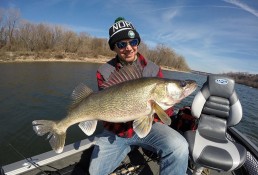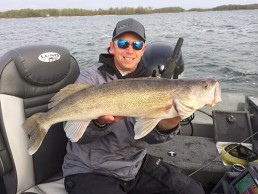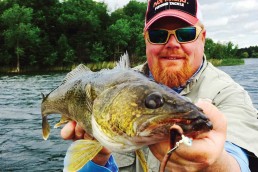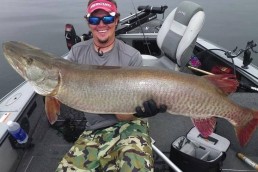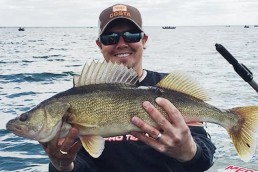Solving the Early-season Walleye Puzzle on Leech Lake
SHARE THIS POST
April means the NFL Draft is here, and for football wonks, it is Christmas in April. I am also a walleye fanatic, so let me give you the “scouting report” for Leech Lake: It has 112,000 acres, countless points, 195 miles of shoreline and islands galore. Leech boasts a healthy walleye population with multiple year-classes.
If the walleyes were drafting, Leech would be a first-round draft choice for sure. For an angler, however, it can be intimidating if one is attempting to tackle everything at once.
You could take this approach and you drive yourself crazy, leading to frustration and a tough day. Instead, focus on three things: two biological, and one atmospheric. Biologically, you need to know a little about the spawn and what the forage base is doing early on. Atmospheric is a fancy way for me to say check the wind.
To start, focus on classic, predictable spawning and migration routes. Walleyes spawn when the water temps reach the low to mid-40s. Early ice-out and late ice-out will come into play, dictating when they spawn. Let’s assume it is a typical ice-out for Leech Lake, historically the latter part of April. Prime spawning territory for walleyes means current, sand and gravel. This can mean the mouths of creeks and rivers for sure. However, on Leech the bulk of these spawning grounds are found near the numerous points adjacent to sand that warms quickly in spring. Due to its reservoir-like make up, there is constant current here. The points serve as a structure that will help accelerate this current, giving walleyes the biological “trigger” they yearn for in the spring. Typical haunts for Leech include Pine, Stony and the Hardwoods points, but don’t overlook smaller points such as Duck or Oak Point. Don’t let any myth of post-spawn walleyes keep you from fishing, because on a lake system the size of Leech there will be walleyes that are ready to feed.
Forage consideration is another aspect to early-season fishing success consideration. On Leech and a number of other northern Minnesota lakes, this means the spot-tail shiner. Shiners typically spawn in shallow, sandy areas near old bulrushes—again, where the water is going to warm quickly. Leech has vast expanses of such areas located around Goose and Bear islands and up into Portage Bay. Here is the “beauty and the beast” factor of finding the spot-tails: There is ample ground available where you can avoid crowds, while the “beast” of this becomes where to start. Here is where quality electronics come into play. Using My Lowrance, I drive shallow sand flats looking for pockets of sand and emerging sand grass scattered in such areas. Without this benefit I would have a tough time narrowing down where to fish. After the shiners spawn, they will use the pockets of weeds to play an eternal game of hide and seek with the walleyes. Their ability to dart and dodge is key to their survival. Your ability to find pockets of weeds and intercept a walleye or two will be key to an opening-day fish fry.
Are you enjoying this post?
You can be among the first to get the latest info on where to go, what to use and how to use it!
Lastly, any time you fish Leech Lake, be sure to check the wind. The great thing about the majority of points on Leech is that no matter the direction of the wind, the fish will set up along the shore, allowing you to fish them. It goes without saying that if the wind has been blowing consistently in an area for a couple days, then that is even better. However, a sudden change in the wind does not mean the fish will leave that point, especially a lot of the main lake points like Stony, Pine, Ottertail and 5 Mile. Instead, before pulling up stakes, check the other side since those fish likely just repositioned to take advantage of the baitfish buffet the wind is stacking up. Additionally, while the main lake points get a lot of attention, and rightly so, don’t overlook some secondary points found in Agency or Traders bays or around Bear Island. A word of caution: Leech can produce some behemoth waves on the main lake, so use good judgment when heading out to the main lake. No fish is worth putting you or your favorite fishing partner in danger.
Early season on Leech is a great time to be on the water, and rather than throw a dart at the map, use a little biology and knowledge of the atmosphere to help narrow down where to start. Leech Lake is perennially an early-season producer and primed to be a top producer again this year. When you are looking to draft a lake for your opening day fishing lineup, Leech should be the “number one” overall pick.
Jim Ernster is a guide and pro staffer with Leisure Outdoor Adventures, a premier fishing guide service in Walker, Minn. Check them out at leisureoutdooradventures.com, or call 855-562-4665.
MWO
SHARE THIS POST
Did you enjoy this post?
You can be among the first to get the latest info on where to go, what to use and how to use it!
Jim Ernster
Jim Ernster is a guide and pro staffer with Leisure Outdoor Adventures, a premier fishing guide service in Walker, Minn. Check them out at leisureoutdooradventures.com or call 855-562-4665.
